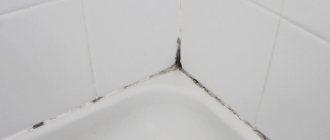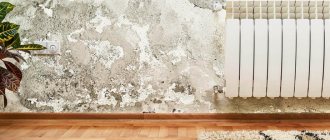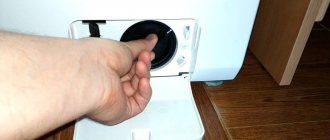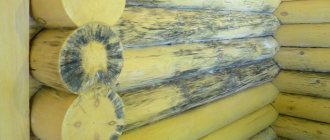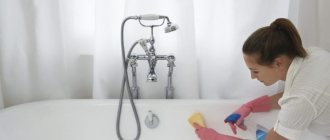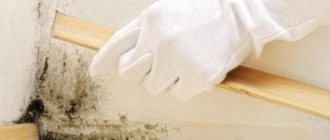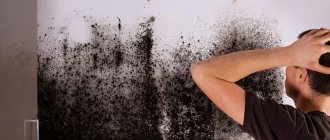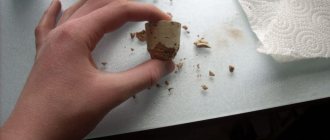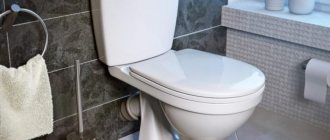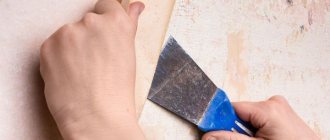The fact that black and gray plaque on the walls and ceiling in the bathroom is unaesthetic is not the biggest problem. It causes the greatest harm to health. The consequences of toxic spores getting into the lungs or bronchi can be the most unpredictable. Treatment after this will require long and serious treatment.
Therefore, if black mold is found in the bathroom, how to get rid of it must be decided immediately. Otherwise, it will quickly penetrate deep under the tiles, and it will not be easy to remove it from there. Our article is dedicated to ways to combat fungus - in this material we examined in detail the best store-bought and folk remedies for removing mold at home.
They also provided useful recommendations on the use of antiseptics and described preventive measures that can prevent the formation of fungus in the bathroom.
Causes of mold
Mold intervention is inevitable if the room:
- poorly ventilated;
- there is no natural light;
- Condensation forms on pipes and wall decoration;
- pipes leak at joints;
- it doesn't heat well.
Even one of these factors creates favorable conditions for its replication. Before it has time to spread to other rooms, urgent measures need to be taken. We talked in more detail about the danger of a person living with black mold here.
And mold spores can get inside through a window, caught in a draft, they penetrate through the front door. They can be brought on shoes and outerwear, and there are other ways. Well, the bathroom is the most fertile area for fungus.
If you do not immediately remove the water from the tiles after bathing, an environment favorable for mold will appear. In just 24 hours, its colony can increase 9 times
Where to look for fungus?
Even if visually you cannot immediately detect traces of the presence of mold, you should look for it in places hidden from view.
It can be:
- corners of walls in contact with the bathroom;
- gaps between tiles;
- places where plumbing fixtures connect to the walls;
- under the baseboards in the area of the sink and bathtub;
- on the ceiling;
- under the rug on the floor;
- in wood paneling;
- in cups for hygiene items.
Having penetrated into other rooms, the spores, if they do not germinate, retain their ability to reproduce for a long time and are just waiting for favorable conditions.
It is impossible to completely get rid of them, but creating unsuitable conditions for their development is quite possible.
The best commercial mold repellents
In the old days, this problem was solved by a radical method - simply leaving the house infected with mold. Now there are many other ways. Let's look at each of them in detail.
Such a dangerous enemy as black fungus requires immediate action to combat it. The process itself may not be quick and labor-intensive, but not only the type of room, but also your health depends on it
Industrial products are distinguished by the fact that after contact with them, mold loses its aggressive properties within a few hours. Some products need to be used regularly when cleaning, others during repairs. We will consider the characteristics of the best purchased antiseptics below.
No. 1 – Bagi “Anti-mold” spray
It is a good antibacterial agent. It is produced in Israel. It destroys not only visible mold, but also its spores, and also eliminates unpleasant odors.
It goes on sale in 0.5 liter bottles. The composition contains chlorine, surfactants and a maximum of 15% non-ionic surfactants, fragrances.
No. 2 - DEC spray from Neohim
DEC spray does the same job well. At the same time, this anti-mold tool removes limescale, traces of corrosion, and neutralizes odors. Consists of water, active ingredients, disinfectants, up to 5% surfactants, perfume composition.
Glycolic acid, present in the composition in the required concentration, penetrates the structure and removes harmful bacteria to the surface
The product is also good because after its application a hydrophobic layer is created, which protects the surface from fungus in the future.
No. 3 - PROSEPT Bath Fungi
An effective alkaline product for removing mold, produced in Russia. Packaging: 0.5 liter bottle with sprayer. There are 3 modes: OFF - closed state, SPRAY - spray mode with the smallest fraction, STREAM - the ability to apply working fluid in streams.
Has a wide range of functionality. Allows you to stop biological damage at the initial stage, prevent the progression of mold fungi, disinfects, and eliminates the smell of mold.
The negative aspects include the strong smell of bleach.
No. 4 - Cillit Bang spray
It has a powerful formula that allows you to fight black mold. The spray contains a high percentage of chlorine, so the smell is very pungent, but it does its job perfectly.
After applying it, it is better to leave the room for about 20 minutes. When the product takes effect, it must be removed.
No. 5 - Mellerud product from Germany
The product is produced in Germany. Eliminates mold and its spores, disinfects. The working substance is active oxygen. Has a prolonged effect.
Mellerud - packed in a convenient 0.5 liter container with a dispenser spray. This is enough to treat large areas
There is no chlorine in the composition, there is no smell. The product is suitable for processing many types of materials - stone, tiles, plaster, fabric.
If the surface is heavily infected with mold, apply liquid to it using a spray bottle and leave it there overnight. From moderately contaminated areas, remove the product an hour after application using a brush or soft cloth. Afterwards the entire area is washed.
In addition to these products, there are other antiseptics that are ideal for protecting walls from mold and fighting fungus when it appears. We recommend that you familiarize yourself with the best antifungal products for walls.
Household chemicals
Designed to quickly and effectively remove fungus, household chemicals can clean contaminated surfaces several times faster than any folk remedy.
If you are not allergic to the components of antifungal drugs and there are no pets in your apartment, then feel free to use special anti-mold chemicals.
"Belizna" - chlorine-based solution
The most famous and inexpensive product called “Whiteness” for 50 rubles. Excellent removes mold stains from various surfaces.
Spraying a bleach solution onto a whitewashed ceiling will remove mold stains and stop mold growth.
To prepare the solution:
- Bleach is diluted with water in a ratio of 1 to 10.
- Apply it to a cleaned surface and wait for it to dry.
The disadvantage of this product is the specific smell of chlorine.
Oxygen bleach
It is based on sodium percarbonate , which can cope with different types of mold.
This product is well suited for removing stains from colored surfaces. With its help, you can remove fungus from curtains in the bathroom, remove black stains from tile joints, curtains, etc.
There is a large selection of such bleaches on sale. The most famous:
- "Bos Plus" costs about 30 rubles;
- “Sano Oxygen”, it can be bought for 280-300 rubles;
- “Vanish Gold” for 140-150 rubles.
Special antifungal
Such products are distinguished by their speed of action and effectiveness . With its help you can easily tidy up:
tiles;- plumbing;
- shower cabin.
Cleaning surfaces will take from 10 minutes to an hour . The most popular products today are:
- “Cillit Bang”, price 150-170 rubles;
- spray “Unicum”, costing about 180 rubles;
- “Turbo”, priced at 300-350 rubles.
Folk remedies against mold
Opponents of the use of aggressive chemicals to destroy black fungus often use improvised means. Many of them give good results.
Remedy #1 - baking soda in tandem with vinegar
Black mold recedes in front of such a simple remedy as soda ash - soda ash or regular in tandem with vinegar.
It’s easy to prepare the mixture:
- take 5 liters of water, but only hot;
- throw 150 g of soda ash or 150 g of regular soda into it;
- to this add 9% vinegar - 100 g.
Having received a foamy liquid, problem surfaces are treated with it. On a horizontal surface, you can remove blackness more easily. Strongly overgrown mycelium is removed with a spatula, and then these areas are sprinkled with soda. Next, put a spray bottle on the bottle with vinegar and spray the surface to extinguish the soda.
A mixture of soda and vinegar works well against mold that has settled in the seams of facing tiles. After 20 minutes of action of the mixture, it is washed off with a brush.
The mycelium dies during the process of foaming, indicating that sodium bicarbonate has reacted with acetic acid.
If there is a washing machine in the bathroom, mold can grow there too. Often black marks can be seen on the sealing rubber, but it is much worse when it penetrates inside the tank. You can remove it from there using vinegar and “Whiteness”.
To do this, these two components are mixed in equal proportions. The powder compartment is soaked in this solution for half an hour. Afterwards, clean it with a brush.
The solution is poured into the machine and, having set it to the longest mode, the highest temperature, it is turned on. Under the influence of high temperature and active substances, microorganisms will die.
We looked at other ways to get rid of mold in a washing machine in the following material.
Remedy #2 – tea tree oil
This non-standard method gives a good result, because... mold microorganisms are sensitive to the components that make up this aromatic oil.
The usage scheme is as follows:
- Buy a bottle of tea tree oil.
- Hands need to be protected, so rubber gloves are also needed.
- Take a spray bottle and pour water into it.
Add 2 large spoons of aroma oil to 500 ml of water. Stir the mixture, pour it into the bottle, and shake. After this, the product can be used for processing.
After application, the mixture does not need to be washed off; it should work. Since the product is natural, it is safe for both people and pets.
It is sprayed on the affected surface, then the fungus is collected with a cloth. To enhance the result, it is advisable to repeat the procedure and leave the treated area to dry naturally.
If the walls in the bathroom are severely damaged, you need a more concentrated solution - 20 ml of oil per 1000 ml of water. It is best to do the treatment using a brush with a long handle.
Since the product has a specific odor, it does not dissipate quickly. To protect your walls from possible damage from black mold in the future, you can add a little oil to the paint. This will stop the development of the colony if mold penetrates thoroughly into the thickness of the wall.
Remedy #3 - Hydrogen Peroxide
This tool is available and inexpensive. There is no need to do any manipulations with it. It is simply poured into a container with a spray bottle and sprayed undiluted. After 15 minutes of exposure, the treated areas are wiped.
Not every surface can be treated with a preparation such as 3% hydrogen peroxide, since it tends to bleach some materials. To be on the safe side, you need to test its effect in a small area.
With the same success, perhydrol can be replaced with furatsilin or copper sulfate.
Remedy #4 - boric acid
Borax, borax or boric acid is the name of one drug. Half a glass of the substance is diluted in a liter of water. The tile seams and other places where mold is found are cleaned with a stiff brush dipped in a solution. After some time, wipe the treated areas with a dry cloth.
There is one unpleasant moment in this process - the substance is not entirely safe, because it irritates the respiratory tract. Therefore, gloves and a mask must be mandatory when processing borax.
It is also advisable to perform work in the absence of children and pets.
Remedy #5 - aqueous ammonia
Non-porous surfaces in the bathroom are well cleaned and disinfected with ammonia. Ammonia is simply applied to the surface using a sponge or cloth. The effect is increased by adding glycerin in small quantities.
The downside is toxicity. Because of this, it can cause irritation of the mucous membranes and even poisoning.
The mixture is left on the surface for one hour, then washed off with water. When using ammonia, you need to know that it evaporates by 50% of the original volume and does not always have time to react.
Like boric acid, ammonia emits a very strong and pungent odor. This may cause irritation.
Remedy #6 - Chlorine Bleach
This simple remedy poses a threat not only to indoor mold, but also to outdoor mold.
The active component of “Belizna” is the inorganic compound sodium hydrochloride. It has disinfectant and antiseptic properties. The working substance in the bleach is 3 – 6%
The percentage of chlorine in “Belizna” is very high, hence the good disinfecting effect. Among all the available means considered, bleach is the leader. It is also good for removing mildew from boards (various wooden surfaces).
The downside is toxicity. Because of this, it can cause irritation of the mucous membranes and even poisoning.
Remedy #7 - copper sulfate
This product kills mold from tiles, primers, and plastic. It needs to be diluted with water. The proportion is 100 g of substance per 10 liters of liquid. The solution is applied to the surface with a brush; it is better to do this in several layers. For prevention, a product is also applied around the area with mold.
Everything is left in this state for some time. Next, you should wash the treated areas and ventilate the room. The product is toxic, so you will need a respirator and gloves to work with it.
Mechanical methods for removing mold
There are three mechanical ways to combat various fungi in the bathroom. This includes cleaning porous materials with an abrasive tool, washing soft products, and washing hard surfaces.
Mechanical methods are combined with treatment with anti-mold agents (chemical method). The effect of the drugs is supported by disinfection with a UV lamp in the bathroom, air filtration or other physical means.
They must wear a respirator. Mold spores penetrate the lungs and can cause fungal infections of internal organs or aspergillosis.
How to remove mold on various bathroom surfaces:
- On silicone/acrylic sealant, remove the affected layer with a scraper, knife, tweezers and sponge. Next, the seams and base are washed with non-metallic brushes + fungicidal agents, rinsed with water, and dried with a hairdryer. Treat with anti-mold preparations and allow to dry. A new layer of silicone is applied.
- On a suspended ceiling in a bathroom, the ceiling material is not susceptible to damage by mold. The contaminated surface is washed with soapy water and a rag (for glossy ones) or a soft brush (for satin, matte ones). Wipe dry with microfiber cloths.
- On bathroom plaster, surface deposits on the walls or ceiling are washed with anti-fungal solutions, stains are bleached with bleaching disinfectants. If mold has penetrated deep into the plaster, the lining is removed down to the base. Then they irrigate with fungicide, dry, and re-plaster.
- From tiles in the bathroom - deposits on mosaics, stone plates, ceramic, glossy or unglazed tiles are removed with washing solutions and soft sponges or brushes.
- Between tiles and mosaic fragments - clean superficially with soft brushes and detergent. Blackened seams are decolorized with chlorine solutions. In advanced cases, the grout is removed, disinfected with a fungicide, dried, and a new layer is applied.
- On curtains in the bathroom - moldy fabric is soaked in a bleach solution (with hydrogen peroxide, chlorine, soda + citric acid). Then wash with powder. A curtain made of PVC, polyester or film is wiped with a rag and warm soapy water, rinsed with water, and the moisture is blotted with a napkin.
After work, throw away the respirator, used gloves, rags, sponges, and other soft equipment. Scrapers, blades, cutters and other working tools are disinfected with a fungicidal disinfectant. This will prevent mold spores from spreading throughout the house.
Some tips for using the products
When planning to use one or another remedy for black mold, you need to take into account a number of features. Firstly, it is impossible to remove this scourge by washing off with warm soapy water with manganese. Even if it is possible to eliminate the black plaque, disputes will remain. Having received a new nutrient medium in the form of warm moisture and the components that make up the soap, their colonies will begin to multiply even faster.
It only takes two years for black mold to destroy building structures. In favorable conditions, she will not stop at the bathroom, but will capture new territories
Secondly, it is impossible to avoid the re-invasion of mold after removing it mechanically. The spores will remain and continue to reproduce.
Thirdly, high positive temperatures, as well as very low ones, are not able to destroy mold spores. Their presence will only stunt growth. Once favorable conditions return, the mold will continue to grow.
Fourthly, the smallest cracks in the bathroom wall need to be repaired, and the walls that are in contact with the street should be insulated. The rugs on the floor in this room should be dry, or even better, have a warm floor here.
Fifthly, it is advisable not to dry wet laundry in the bathroom. It will become an additional source of moisture. When zonal surface treatment does not help, you will have to make repairs throughout the entire room. For this purpose, purchase products intended for use during repairs. They are added to putty, paint or whitewash.
The process of renovating a bathroom is labor-intensive and requires both time and money. But it is almost impossible to deal with old mold in any other way.
Pay attention to primers that are based on acids and other components that have a detrimental effect on mold.
Where does mold grow
First of all, you need to find the places that mold loves so much. There are a lot of them in the bathroom. It is worth paying attention to the walls, ceiling, corners, also a favorite place for mold - the joints of tiles and panels, and, of course, water and sewer pipes.
The most common mold is black mold, Aspergillus niger. This mold looks very characteristic - dots and blurry spots of black color.
Unfortunately, fungal spores are constantly in the air. They are in “sleep” mode and can wake up only under certain conditions favorable to them.
They grow quite quickly, form colonies and easily begin to capture more and more new areas.
Favorable conditions mean several factors:
- Humidity above 80%.
- Temperature is more than +20°C.
- Cracks and poor tightness of the joints of walls and ceilings or finishing materials.
- Violation of ventilation.
- Freezing of walls.
However, the last point rarely applies to the problems of bathrooms and is more suitable for outdoor buildings, but it also cannot be excluded.
How to prevent mold?
This uninvited guest feels comfortable in a room where there is absolutely no ventilation and drafts in conditions of high humidity - from 80% and a temperature of 20⁰. Based on this, it is necessary, first of all, to create an environment in which mold cannot develop in principle.
To maintain constant humidity levels in the bathroom, you do not need to close the door tightly. If this measure is not enough, you will have to arrange ventilation. You can install a door with special holes for ventilation or drill them yourself, then decorate them with decorative rings.
The door model with holes equalizes the temperature inside the bathroom. Ventilation holes come in the form of circles or rectangles. They are performed in several zones or one and are masked with a decorative lattice.
A more effective way is to install a fan in the air duct. The hole is sealed with a ventilation grill. Switching on and off can be done using the light switch.
The best option is to install a hygrometer and connect it to the fan via a sensor. Once the humidity reaches the upper limit, it will turn on the fan. When the humidity value drops, the device turns on again.
You can buy a ventilation grill and install it yourself, but then the integrity of the door leaf is compromised.
If you follow all our recommendations, the issue of black mold will no longer bother you.
The most vulnerable places for plaque to appear
First of all, mold settles in the seams between the tiles, as well as in places where plumbing fixtures are connected to the walls using sealant.
Washing off black deposits from such surfaces is a difficult and sometimes impossible task. Therefore, grout and sealant must be changed periodically .
The seams between the tiles are cleaned with a stiff metal brush, treated with an antiseptic and filled with grout with a special antifungal additive.
The sealant is removed from the joints with a special knife. The joint area is treated with a mold remover and the surface is allowed to dry. Then new sealant is applied to the prepared areas.
Read more about ways to remove mold on bathroom caulk here.
In the bathroom, mold may appear on the ceiling. If the affected area is small, you can treat the surface with bleach or another antifungal agent.
If bubbles of swollen plaster appear on the ceiling, then you will not be able to cope with the mold without repair work. You will have to remove the plaster .
To do this, moisten the ceiling with water using a brush for 2-3 hours. After this, the plaster can be easily removed.
Surface unevenness must be thoroughly puttied . After this, the ceiling is treated with an antifungal primer. Then you can complete the final finishing of the ceiling.
